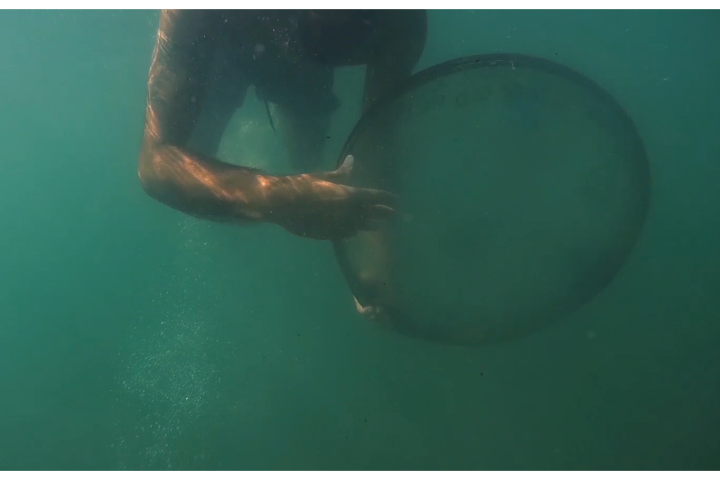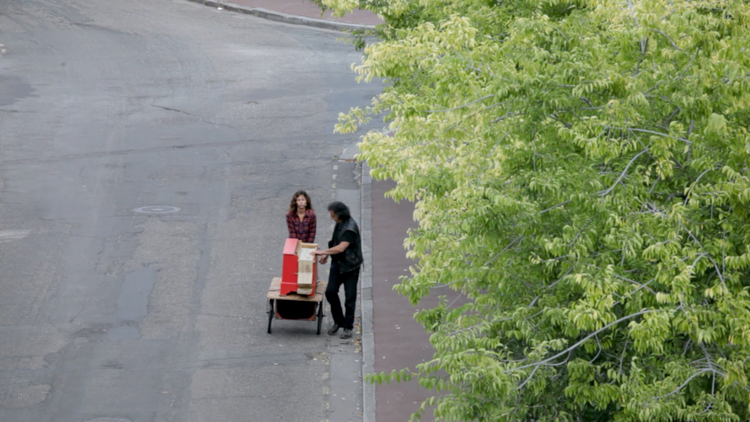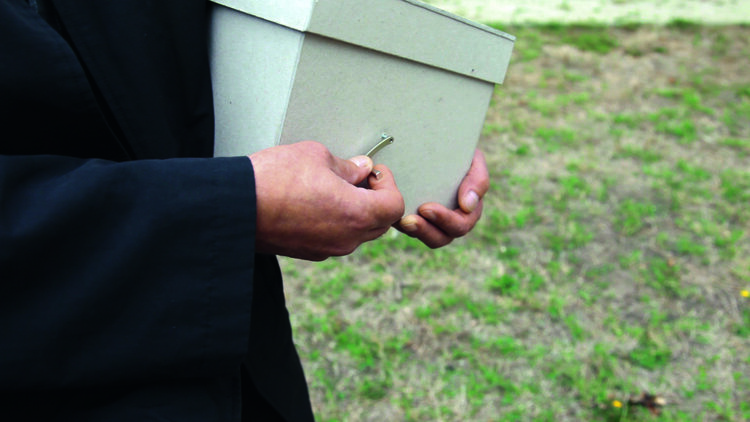TINI
FİKRET ATAY, ANRI SALA
BİLSART
www.bilsart.com
Art Talks: Fikret Atay & Derya Yücel
02.01.2020
Bilsart hosts the group exhibition “Tını”, curated by Derya Yücel, between January 2 - 31.
How can one think of a political life framed by the idea of a happy life? Can community be possible for those who do not have associations? In line with his political philosophy, Agamben expresses his ideas on how to move from the naked life to the political life through the “The Coming Community”. Instead of ‘unity’ as unification around common goals, the idea of “a community that is not based on association” is put forth. It is argued that community can be built on the most common, without any belonging. Association is an intimacy that we cannot represent or conceptualize. “This objectless distribution that constitutes politics is this unique co-sensation” (p.78)
“TINI” which cannot be grounded in association but focuses on the sound and music phenomenon with reference to the most common, brings together the video productions of Anri Sala and Fikret Atay. “TINI”, which emphasizes community (without association) and does not emphasize unity (not based on association), is founded upon a unique co-sensation. It underscores the coherence of different attitudes that have all the characteristics of singularity within it and can be shared with this specificity. TIMBRE is defined as the distinguishing feature of organized sounds (music) rather than an expression of a combination of form, structure and emotion with the relational nature of sound in meaning. TIMBRE, as the characteristic tone color in a sound –even when the pitch, height and intensity are the same– distinguishes these sounds and becomes a metaphor for the area where differences associate. The sound, music and rhythm that determine the concept of the association in the videos of the artists are becoming public rather than a personal experience and become an association based on different narratives and expression strategies.
FİKRET ATAY
AQUAMAN
January 02-14, 2020
Fikret Atay's 2019 video work “Aquaman” starts with a timbrel sound that comes before the image. The half-naked figure, which we see in an unspecified natural landscape, continues to play the timbrel and slowly moves towards the lake. The figure’s effort to continue the action, which is slowly buried in the water, and the effort of the water to prevent this action, becomes a kind of silent struggle. This state of action, which presents the indicators of ability and inability to be heard, to struggle, to surrender and to continue, turns into an intense war of will. Although the end is unpredictable, Aquaman brings the viewer to a common sense of communicating his determination and, in spite of everything, shares his hope of breathing.
About FİKRET ATAY:
Fikret Atay Born in 1976, Batman, Turkey. Lives and works in Örebro, Sweden. The video artist Atay focuses on the conflicts; east and west, tradition and modernity, civil and military. His sincere and simplistic approach enables the audience with a wider apprehension of the smallest local issues. The artist approaches to diverse notions of the everyday life and reveals the redemptive potential of creativity. He uses paradoxes to question the political oppression, military intervention, the conjunction between local and global, tradition and experimentation. It is likely to see music as a form of rebellion and youthfulness as a symbol of hope. As it is impossible to get rid of our emotions while watching a video of Atay’s we mobilize and get lost in his sophisticated humor.
His work has been shown in international museums and art centers, including Centre Pompidou, Paris, France; Castello di Rivoli, Torino, Italy; MAXXI, Roma, Italy; Pinchuk Art Center, Kiev, Ukrania; Museum of Modern Art, San Francisco, USA; Hammer Museum, LA; Museum of Contemporary Art, Chicago; Portikus, Frankfurt, New Museum, New York; MoMA PS1, New York, USA. He has been invited in important biennials as Sydney Biennial, Australia; Lyon Biennial, France; Istanbul Biennial, Turkey. His video work is part of important museum collections.
ANRI SALA
LE CLASH
January 16-31, 2020
Anri Sala's 2010 film entitled “Le Clash” begins with a familiar melody that accompanies the image of an abandoned concert hall. In the footage, two stray street musicians meet a stray and lonely figure, who has turned a shoe box under his arm into an instrument, meet in different scenes simultaneously. When these different melodies are combined, the song “Should I Stay or Should I Go? " by a British punk rock band, which was founded in 1976 and disbanded in 1986 and had made political stance an integral part of their music, integrating themes such as racism, violence, exploitation and war into punk aesthetics. As the melody of the song is brought into the present day, the sound echoes in the desolation of this abandoned building, which was once a common place. This timbre, flowing from the past to the future, is reminiscent of the association on the possibility of hope, resistance and belief.
About ANRI SALA:
Anri Sala constructs transformative, time-based works through multiple relationships between image, architecture, and sound, employing these as elements to fold, capsize, and question experience. His works investigate ruptures in language, syntax, and music, inviting creative dislocations which generate new interpretations of history, supplanting old fictions and narratives with less-explicit, more-nuanced dialogues.
His work has been the subject of solo exhibitions at the Castello di Rivoli, Turin (2019); Museo Tamayo, Mexico City (2017); the New Museum, New York (2016); Haus der Kunst, Munich (2014); Centre Pompidou, Paris (2012); Serpentine Gallery, London (2011); Museum of Contemporary Art North Miami (2008); and ARC, Musée d’Art Moderne de la Ville de Paris (2004).
He has also participated in major group exhibitions and biennials internationally, including the Fifty-seventh Venice Biennale (2017), documenta (13) (2012), the Twenty-ninth São Paulo Biennial (2010), the Second Moscow Biennale of Contemporary Art (2007), and the Fourth Berlin Biennale (2006). In 2013, he represented France in the Fifty-fifth Venice Biennale.



FİKRET ATAY, ANRI SALA
BİLSART
www.bilsart.com
Art Talks: Fikret Atay & Derya Yücel
02.01.2020
“The hope here is may begin after people’s perception of "non-existence":
we must exist and we can only co-exist”.
Agamben, G.
Bilsart hosts the group exhibition “Tını”, curated by Derya Yücel, between January 2 - 31.
How can one think of a political life framed by the idea of a happy life? Can community be possible for those who do not have associations? In line with his political philosophy, Agamben expresses his ideas on how to move from the naked life to the political life through the “The Coming Community”. Instead of ‘unity’ as unification around common goals, the idea of “a community that is not based on association” is put forth. It is argued that community can be built on the most common, without any belonging. Association is an intimacy that we cannot represent or conceptualize. “This objectless distribution that constitutes politics is this unique co-sensation” (p.78)
“TINI” which cannot be grounded in association but focuses on the sound and music phenomenon with reference to the most common, brings together the video productions of Anri Sala and Fikret Atay. “TINI”, which emphasizes community (without association) and does not emphasize unity (not based on association), is founded upon a unique co-sensation. It underscores the coherence of different attitudes that have all the characteristics of singularity within it and can be shared with this specificity. TIMBRE is defined as the distinguishing feature of organized sounds (music) rather than an expression of a combination of form, structure and emotion with the relational nature of sound in meaning. TIMBRE, as the characteristic tone color in a sound –even when the pitch, height and intensity are the same– distinguishes these sounds and becomes a metaphor for the area where differences associate. The sound, music and rhythm that determine the concept of the association in the videos of the artists are becoming public rather than a personal experience and become an association based on different narratives and expression strategies.
FİKRET ATAY
AQUAMAN
January 02-14, 2020
Fikret Atay's 2019 video work “Aquaman” starts with a timbrel sound that comes before the image. The half-naked figure, which we see in an unspecified natural landscape, continues to play the timbrel and slowly moves towards the lake. The figure’s effort to continue the action, which is slowly buried in the water, and the effort of the water to prevent this action, becomes a kind of silent struggle. This state of action, which presents the indicators of ability and inability to be heard, to struggle, to surrender and to continue, turns into an intense war of will. Although the end is unpredictable, Aquaman brings the viewer to a common sense of communicating his determination and, in spite of everything, shares his hope of breathing.
About FİKRET ATAY:
Fikret Atay Born in 1976, Batman, Turkey. Lives and works in Örebro, Sweden. The video artist Atay focuses on the conflicts; east and west, tradition and modernity, civil and military. His sincere and simplistic approach enables the audience with a wider apprehension of the smallest local issues. The artist approaches to diverse notions of the everyday life and reveals the redemptive potential of creativity. He uses paradoxes to question the political oppression, military intervention, the conjunction between local and global, tradition and experimentation. It is likely to see music as a form of rebellion and youthfulness as a symbol of hope. As it is impossible to get rid of our emotions while watching a video of Atay’s we mobilize and get lost in his sophisticated humor.
His work has been shown in international museums and art centers, including Centre Pompidou, Paris, France; Castello di Rivoli, Torino, Italy; MAXXI, Roma, Italy; Pinchuk Art Center, Kiev, Ukrania; Museum of Modern Art, San Francisco, USA; Hammer Museum, LA; Museum of Contemporary Art, Chicago; Portikus, Frankfurt, New Museum, New York; MoMA PS1, New York, USA. He has been invited in important biennials as Sydney Biennial, Australia; Lyon Biennial, France; Istanbul Biennial, Turkey. His video work is part of important museum collections.
ANRI SALA
LE CLASH
January 16-31, 2020
Anri Sala's 2010 film entitled “Le Clash” begins with a familiar melody that accompanies the image of an abandoned concert hall. In the footage, two stray street musicians meet a stray and lonely figure, who has turned a shoe box under his arm into an instrument, meet in different scenes simultaneously. When these different melodies are combined, the song “Should I Stay or Should I Go? " by a British punk rock band, which was founded in 1976 and disbanded in 1986 and had made political stance an integral part of their music, integrating themes such as racism, violence, exploitation and war into punk aesthetics. As the melody of the song is brought into the present day, the sound echoes in the desolation of this abandoned building, which was once a common place. This timbre, flowing from the past to the future, is reminiscent of the association on the possibility of hope, resistance and belief.
About ANRI SALA:
Anri Sala constructs transformative, time-based works through multiple relationships between image, architecture, and sound, employing these as elements to fold, capsize, and question experience. His works investigate ruptures in language, syntax, and music, inviting creative dislocations which generate new interpretations of history, supplanting old fictions and narratives with less-explicit, more-nuanced dialogues.
His work has been the subject of solo exhibitions at the Castello di Rivoli, Turin (2019); Museo Tamayo, Mexico City (2017); the New Museum, New York (2016); Haus der Kunst, Munich (2014); Centre Pompidou, Paris (2012); Serpentine Gallery, London (2011); Museum of Contemporary Art North Miami (2008); and ARC, Musée d’Art Moderne de la Ville de Paris (2004).
He has also participated in major group exhibitions and biennials internationally, including the Fifty-seventh Venice Biennale (2017), documenta (13) (2012), the Twenty-ninth São Paulo Biennial (2010), the Second Moscow Biennale of Contemporary Art (2007), and the Fourth Berlin Biennale (2006). In 2013, he represented France in the Fifty-fifth Venice Biennale.


